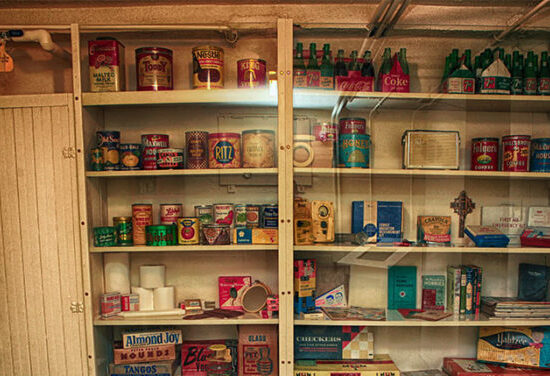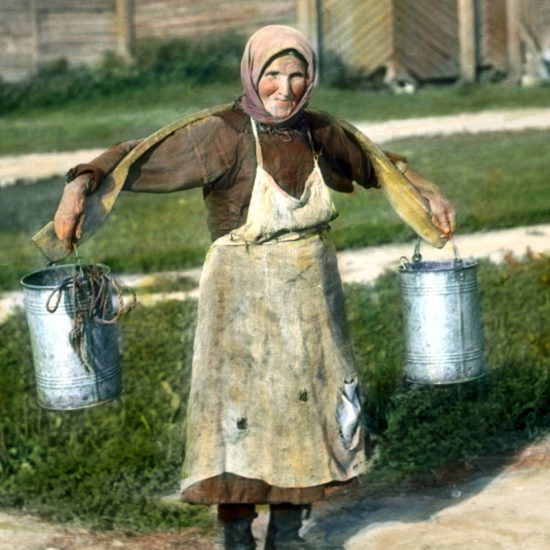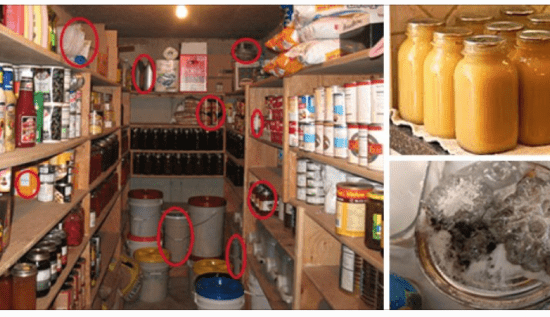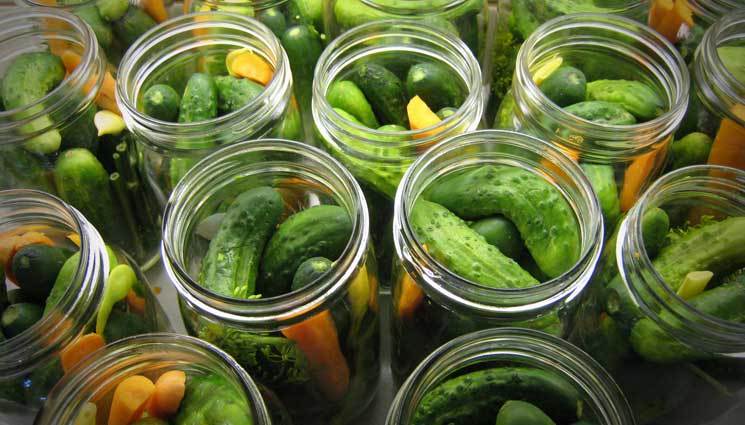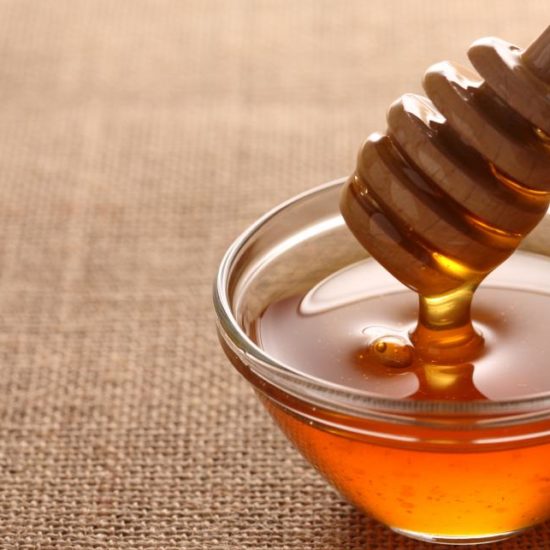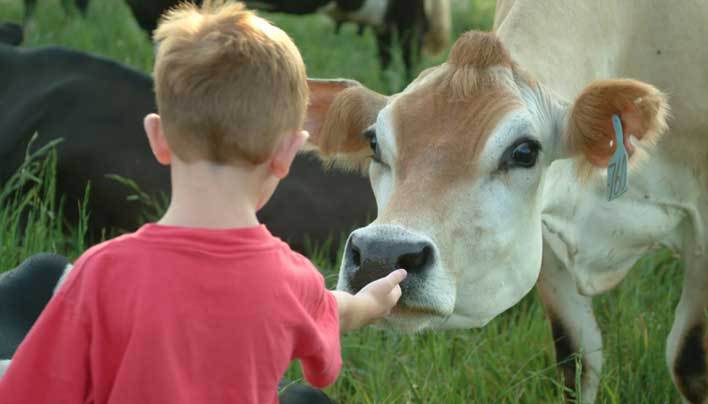
Tibby is a young barn cat that will need to be euthanized within the next few days. She is less than a year old and is suffering from a very aggressive form of cancer.
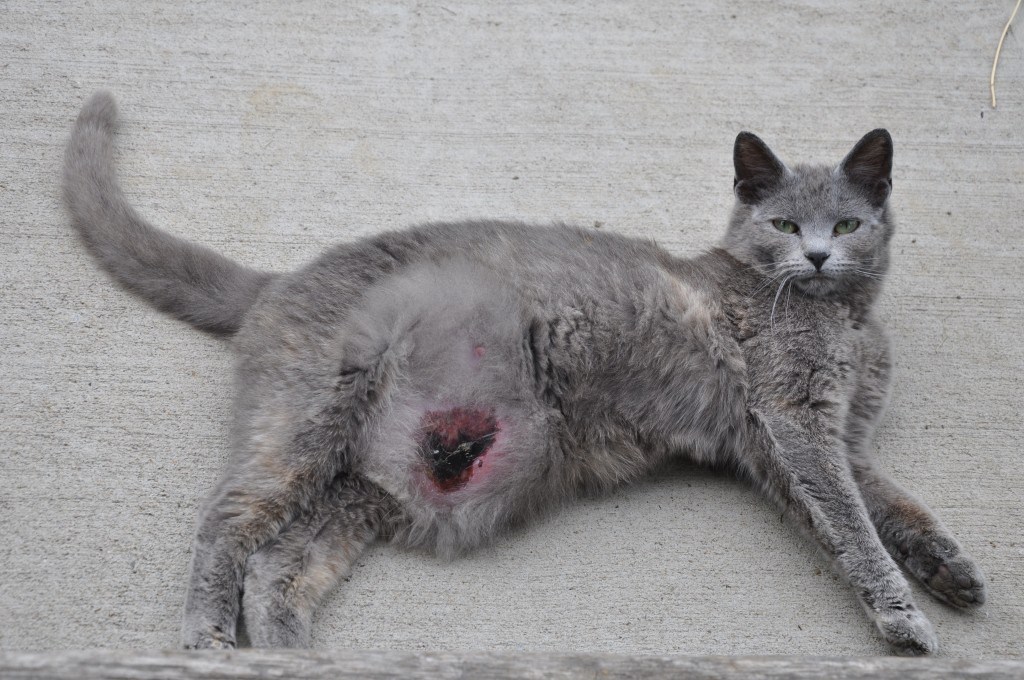
For the past week I’ve been spending extra time with her and feeding her all the milk and cheap bologna she cares to eat.
She doesn’t seem to be in any pain just yet. I’m watching her carefully for the first signs of pain; or for a change in her behavior or for the tumor to begin to rupture. At the first hint of a change my husband or I will euthanize her quietly here on the farm.
Without a doubt one of the most unpleasant but vital self-reliance and agrarian skills is the ability to quickly and painlessly euthanize sick or suffering animals and livestock.
For most animals the preferred method on this farm is a well-placed bullet to the front or back of the head while the animal is eating or distracted in some way. That’s how Tibby will be released. She will be shot from behind while she is eating and her death will be instantaneous and she will never know any pain.
On our farm we use small-caliber bullets for small animals and a larger caliber for large livestock. Chickens, ducks and other poultry are not shot but instead quickly euthanized with a broomstick. We never use the services of a veterinarian for euthanasia due to cost, time considerations and because it is less stressful for the animal to be put down by someone they know and trust.
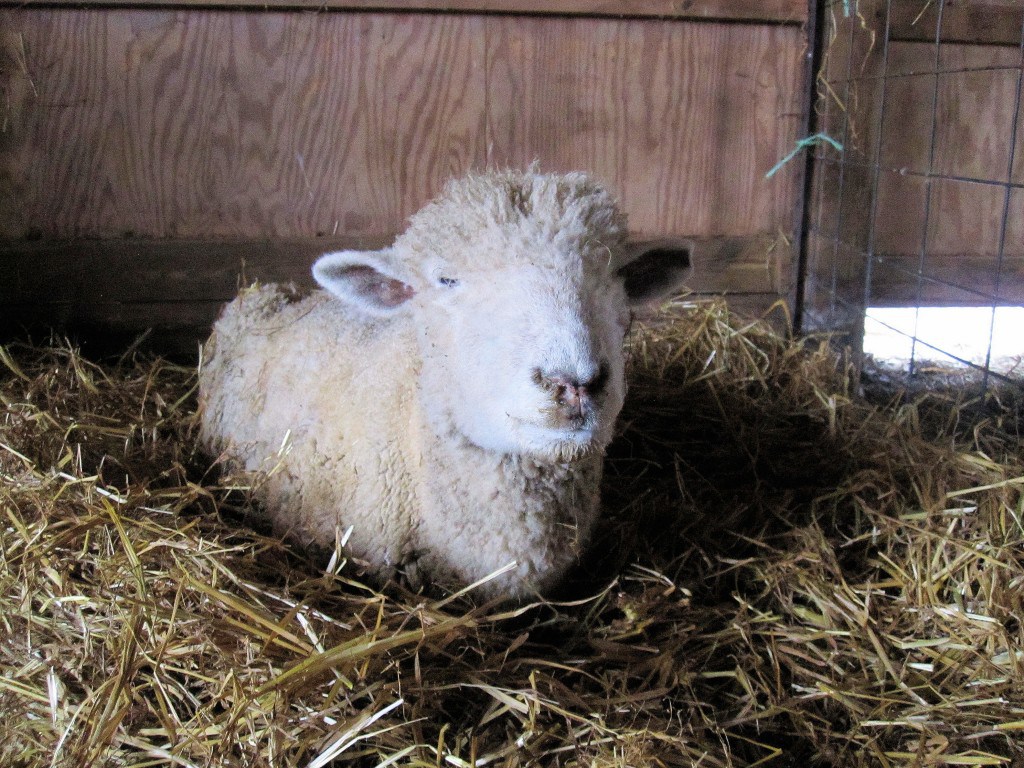
I prefer a .22 caliber bullet for cats, small dogs, goats and light pigs, and a .38 caliber hollow point for sheep, cattle, horses and heavy hogs. My husband prefers the .45 Long Colt for larger animals. It doesn’t matter if the shot is made from a rifle or a handgun. However a rifle produces a higher velocity bullet and that can be an important consideration in some situations. I almost always use a handgun when I have to destroy an animal because it’s what I’m comfortable with. But at times it can be safer for the shooter to use a rifle if the animal is very large and in pain. An animal in pain is unpredictable and can be dangerous.
Whenever possible I restrain and remove the animal from the other animals so that they don’t witness the killing. Some people say it doesn’t matter but I think that it does. Animals understand a lot more than we sometimes give them credit for.
When euthanizing an animal the most important thing to keep in mind is safety for the shooter and to any other creatures nearby. It is safest to have any bystanders stand behind the shooter and well back away from the animal.
If at all possible I try to move the animal out-of-doors and not take the shot in the barn if I can help it. A ricochet bullet is unlikely, but I do take care that nothing obviously hard or solid is in my way or in the line of fire. That said if it is too stressful or upsetting to the animal to be moved, I will shoot it in the barn.
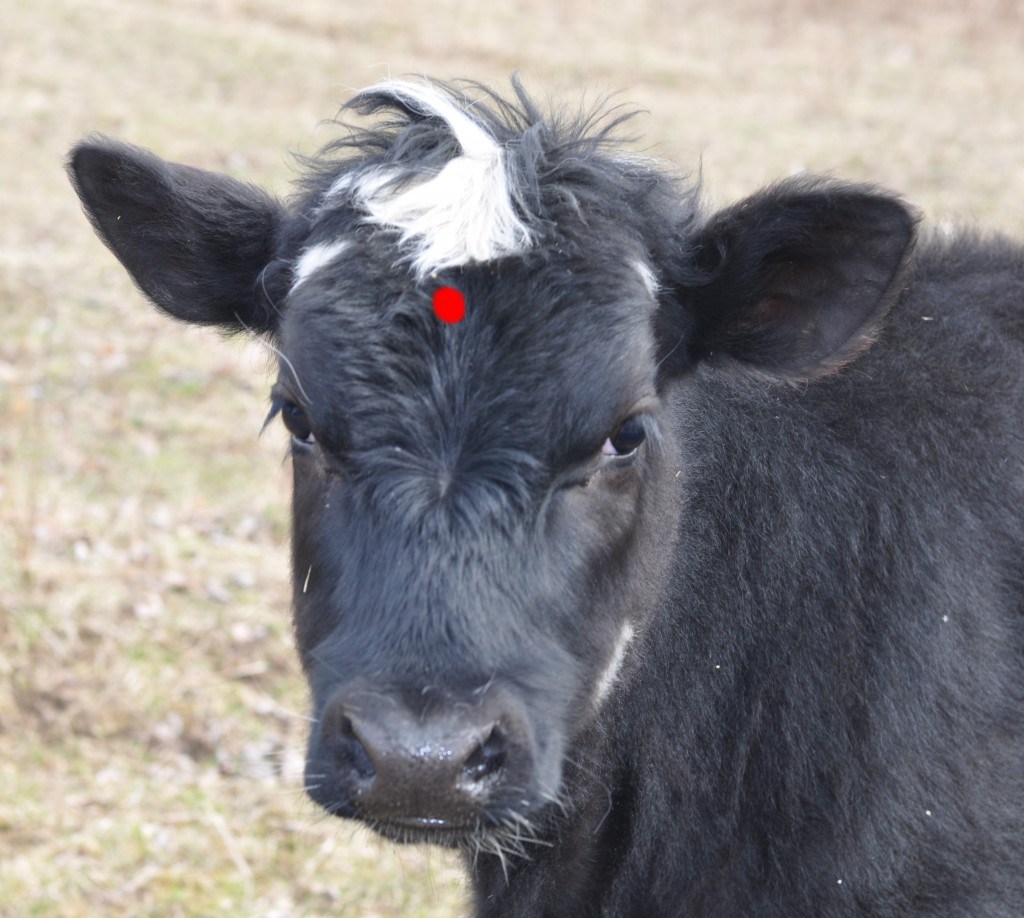
Outdoors, I try to take the shot while standing behind the animal and facing downhill if I’m on a hill. That’s because an animal will often lunge forward when first shot and it is easier to back up.
Almost always animals will jerk, thrash and twitch when shot in the head and it is important to be able to step out-of-the-way so as not to be accidentally hurt.
The most effective head shot is a shot that is taken 3” -12” away from the back or front of the head and not with the muzzle of the gun placed directly on the head. A little extra distance allows the shooter to shift if the animal moves.
Photos are not 3 dimensional and have limitations. But in general, the shot should be aimed downward directly between the ears when standing behind the animal or between the eyes or mid-line on the forehead when in front of the animal. The angle of the shot and placement depends upon the species and where the shooter is positioned.
This is where it’s important to be aware of the basic physiological differences in livestock and small animals. Take the time ahead of time to learn how the animals you keep and are responsible for are put together.
Skull shape and exact brain location is not the same in all animals. The more precisely a bullet is placed into the center of the brain – the more catastrophic the tissue damage. Catastrophic damage results in a merciful and quicker kill. It’s a case of lights on – then lights off – and there is no pain for the animal. It’s a complete short circuit from the brain to the body.
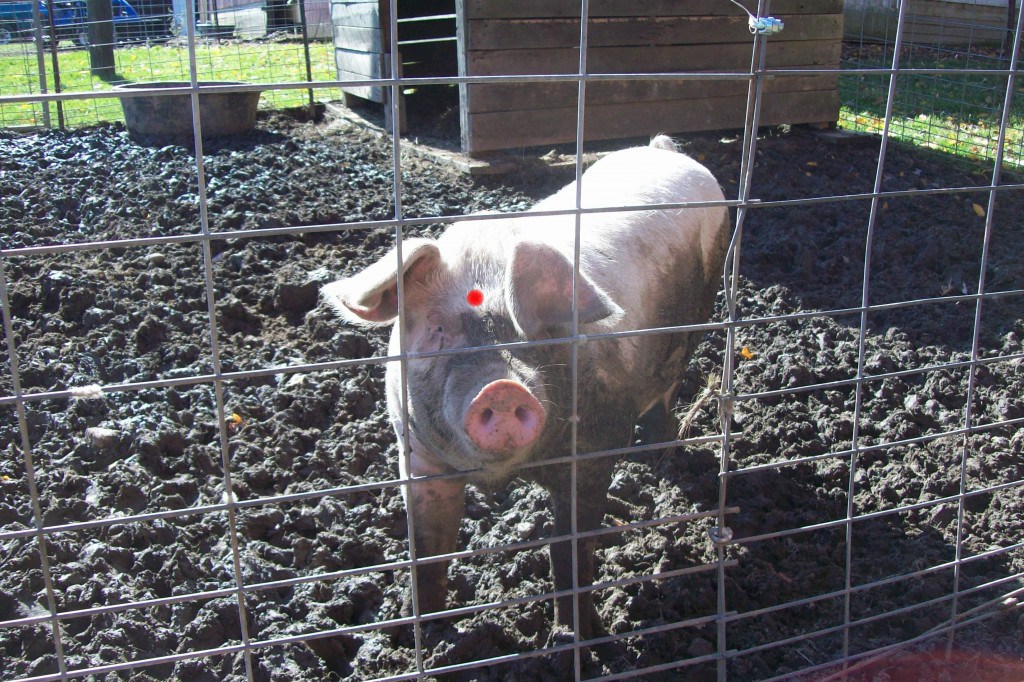 Bullet Placement In A Pig
Bullet Placement In A Pig
If you are unsure about exact bullet placement a larger caliber bullet can reduce the margin of error. Two shots fired into the skull in rapid succession will kill or fatally stun most large farm animals.
With chickens, ducks and other poultry I believe the most merciful and quickest killing is by way of cervical dislocation with a broomstick.
I first restrain the chicken and hold its wings in place close to the body. I next place the chicken beak and breast side down on a very firm surface like a cement sidewalk. I then place a broomstick so that it directly spans across the back of the chicken or duck’s neck where the head meets the neck, and step quickly on the left side of the broom stick and then on the right side and pull the chicken’s body backwards by its feet towards me and away from the head and broom stick. By stepping on the broom stick while it spans the chicken’s neck and pulling the body backwards the spinal cord is severed from the brain and death is instantaneous.
The proper disposal of euthanized animals is an important consideration. On this farm all animals are either buried or taken to the woods and left exposed so that other animals can make good use of them.
My pet dogs have been either buried in my flower and rose garden or the hill behind my mother-in-law’s house.
If you know ahead of time that you will need to euthanize an animal it is helpful and practical to have the grave pre-dug or have a plan for the removal of the body.
If you’re going to bury an animal it’s important to be sure to bury it deep enough. Graves should be at least 3’ deep for most animals – deeper for large livestock – and plenty wide. A backhoe and a set of chains are real time savers for large farm animals. Keep the graves well away from wells and other water sources.
No conversation about animal euthanasia would be complete without a mention of the human emotions that are involved.
Speaking from personal experience, I have found that there’s a profound sense of regret, sadness and emptiness when any animal has to be destroyed. A feeling of interior hollowness and the stillness and absolute finality of death is always present. Often there is self-blame whether or not it is merited.
But sometimes euthanasia can be an easy choice with few regrets. I have found this to be especially true with large livestock. When an animal is obviously suffering and there’s no possible hope or remedy for the situation it is easy to take the shot. At those times courage is not needed – only mercy is required. Mercy is a gift that we as humans can bestow upon the animals that serve and depend upon us. Mercy is what helps me to find my target and to remain calm, detached and determined while I do what I must.
But when the animal is a pet or there is a strong emotional attachment, euthanasia can be very hard. It’s at that time that personal courage, bravery and faith is necessary. Because euthanizing a pet is so hard many people will elect to use the services of a veterinarian or call a trusted friend. There’s no shame in asking a friend to shoot your dog or horse. Many country people are glad to help and understand the heartache involved. We unfortunately live in a society that denies death and anthropomorphizes animals so there is bound to be problems when we’re face with the euthanasia of our pets and animals that we love. Often emotions will cloud good judgment and sadly many animals have been held onto way past the time when they should have been allowed to pass away.
I always say a prayer right before I take the life of any animal. I pray that God will steady my hand and give the animal a quick and painless death. I also pray for forgiveness. Never once have I killed an animal that I was not cognizant that death is the cost for this earthly life and that one day I too will be required to pay the price.















